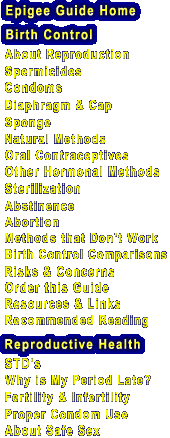

in association with Amazon.com

Woman to Woman:
Your Body and Your Health

Pregnancy: Teen Decisions

Sex: What You Don't
Know Can Kill You



Sexually transmitted diseases, or STDs, are infections that can be transferred from one person to another through sexual contact. According to the Centers for Disease Control there are over 15 million cases of sexually transmitted disease cases reported annually. Adolescents and young adults (15-24) are the age groups at the greatest risk for acquiring an STD, 3 million becoming infected each year.
Most STDs are treatable. However, even the once easily cured gonorrhea has become resistant to many of the older traditional antibiotics. Other STDs, such as herpes, AIDS, and genital warts, all of which are caused by viruses, have no cure. Some of these infections are very uncomfortable, while others can be deadly. Syphilis, AIDS, genital warts, herpes, hepatitis, and even gonorrhea have all been known to cause death. Many STDs can lead to related conditions such as pelvic inflammatory disease, cervical cancer, and complications in pregnancy. Therefore, education about these diseases and prevention is important.
It is important to recognize that sexual contact includes more than just intercourse. Sexual contact includes kissing, oral-genital contact, and the use of sexual "toys," such as vibrators. There really is no such thing as "safe" sex. The only truly safe sex is abstinence. Sex in the context of a monogamous relationship where neither party is infected with a STD is also considered "safe". Most people think that kissing is a safe activity. Unfortunately, syphilis, herpes, and other diseases can be contracted through this apparently harmless act. All other forms of sexual contact also carry some risk. Condoms are commonly thought to protect against STDs. Condoms are useful in helping to prevent certain diseases, such as HIV and gonorrhea. However, they are less effective protecting against herpes, trichomoniasis, and chlamydia. Condoms provide little protection against HPV, the cause of genital warts.
A partial listing of sexually transmitted diseases:
|
Type: Bacterial
Modes of Transmission: Vaginal and anal sex.
Symptoms: Up to 75% of cases in women and 25% of cases in men are asymptomatic. Symptoms may include abnormal genital discharge, and burning during urination in both men and women. Women may also experience lower abdominal pain or pain during intercourse, and men may experience swelling or pain in the testicles.
Treatment: Infection can be cured with antibiotics. However, it cannot undo the damage done prior to treatment.
Possible Consequences for the Infected Person: If untreated in women, up to 30% will experience pelvic inflammatory disease (PID) which in turn often leads to ectopic pregnancy, infertility, and chronic pelvic pain. In men, if untreated, chlamydia can cause epididymitis, an inflammation of a testicle (where sperm are stored), which may result in sterility. Infected individuals are at greater risk of contracting HIV if exposed to the virus.
Possible Consequences for the Fetus and Newborn: Premature birth; infant pneumonia and neonatal eye infections may result from transmission of the disease during delivery.
Prevention: Abstaining from vaginal and anal sex with an infected person is the only 100% effective means of prevention. Latex condoms can reduce but not eliminate the risk of contracting the disease.
Type: Bacterial
Modes of Transmission: Vaginal, anal or oral sex.
Symptoms: Though some cases may be asymptomatic, when symptoms do appear, they are often mild and usually appear within 2-10 days after exposure. The symptoms include discharge from the penis, vagina, or rectum and burning or itching during urination.
Treatment: Infection can be cured with antibiotics. However, it cannot undo the damage done prior to treatment.
Possible Consequences for the Infected Person: Untreated in women, the disease is a major cause of pelvic inflammatory disease. Ectopic pregnancy, infertility, pelvic inflammatory disease (PID), which can lead to ectopic pregnancy, infertility, and chronic pelvic pain. It can cause sterility in men. Untreated gonorrhea can infect the joints, heart valves and/or the brain.
Possible Consequences for the Fetus and Newborn: Gonorrhea can cause blindness and systemic diseases such as meningitis and septic arthritis in infants infected during delivery. To prevent blindness, all newborns delivered in hospitals have their eves treated with medication specific for gonorrhea.
Prevention: Abstaining from vaginal, anal and oral sex with an infected person is the only 100% effective means of prevention. Latex condoms can reduce but not eliminate the risk of contracting the disease during sex.
Type: Viral
Mode of Transmission: Vaginal, oral and especially anal sex; sharing contaminated drug needles; piercing the skin with contaminated instruments such as those used in dental and medical procedures; and receiving contaminated blood or blood products through transfusions.
Symptoms: About one-third of people with HBV are asymptomatic. When symptoms are present they include fever, headache, muscle aches, fatigue, loss of appetite, vomiting and diarrhea. Symptoms of liver involvement include dark urine, abdominal pain, yellowing of the skin and whites of the eyes.
Treatment: There is no known cure. Most infections clear up by themselves within 4-8 weeks. Some individuals become chronically infected.
Possible Consequences for the Infected Person: For those individuals who are chronically infected, the disease can lead to cirrhosis, liver cancer and immune system disorders.
Possible Consequences for the Fetus and Newborn: Pregnant women can transmit the disease to their unborn children. Some 90% of infants infected at birth become chronic carriers and are at risk of liver disease and liver cancer. They are also capable of transmitting the virus. Infants of infected mothers can be given immunoglobulin and vaccinated at birth, potentially eliminating the risk of chronic infection.
Prevention: Abstaining from sex with an infected person, especially anal sex, where body fluids, blood, semen or vaginal secretions are likely to be exchanged, is the only 100% effective means of preventing the sexual transmission of Hepatitis B. Latex condoms can reduce but not eliminate the risk of contracting the disease during sex. Avoid illicit IV drug use and sharing drug needles. Discuss with health care providers precautions that are taken to avoid transmission of Hepatitis B, especially when receiving blood products or blood transfusions. A vaccine is available and is recommended for those at risk of contracting Hepatitis B. Additionally, the vaccine has been added to the routine pediatric immunization schedule recommended by the American Academy of Pediatrics.
Type: Viral
Modes of Transmission: Herpes is spread by direct sexual skin-to-skin contact with the infected site during vaginal, anal or oral sex. Another strain of the virus, Herpes Simplex Type 1 (HSV-1) is most commonly spread by nonsexual contact and usually causes sores on the lips. However, HSV-1 can also be transmitted through oral sex and can cause genital infections.
Symptoms: Symptoms are often very mild and may include an itching or burning sensation; pain in the legs, buttocks or genital area; or vaginal discharge. Blisters or painful open sores may appear, usually in the genital area, buttocks, anus, and thighs, although they can erupt anywhere. Sores heal after several weeks but may recur.
Treatment: There is no known cure. An anti-viral drug is usually effective in reducing the frequency and duration of HSV-2 outbreaks.
Possible Consequences for the Infected Person: An infected person with sores present has an increased risk that exposure to HIV will lead to infection because the sores provide an entry point for the AIDS virus.
Possible Consequences for the Fetus and Newborn: Women who develop a first episode of genital herpes curing pregnancy may be at higher risk for premature delivery. Outbreaks present during labor usually indicate the need for a cesarean delivery because infection passed to the newborn during childbirth may result in possible death or serious brain damage.
Prevention: Abstaining from vaginal, anal and oral sex with an infected person is the only 100% effective means of preventing the sexual transmission of genital herpes. Latex condoms can reduce but not eliminate the risk of contracting the disease during sex. However, it is still possible to contract genital herpes, even though using a condom, via sores in the genital area.
More Information: Click here for frequently asked questions about herpes and the latest developments in diagnosis.
Type: Viral
Modes of Transmission: Vaginal, oral and especially anal sex; infected blood or blood products; sharing drug needles with an infected person; and from infected mother to infant in utero, during birth, or while breastfeeding.
Symptoms: Some people experience no symptoms when first infected. Others have flu-like symptoms including fever, loss of appetite, weight loss, fatigue and enlarged lymph nodes. The symptoms usually disappear within a week to a month, and the virus can remain dormant for years. However, it continues to weaken the immune system, leaving the individual increasingly unable to fight opportunistic infections.
Treatment: There is no known cure. Antiviral drugs are used to prolong the life and health of the infected person. other treatments are used to combat opportunistic infections.
Possible Consequences for the Infected Person: Virtually everyone who becomes infected with HIV will eventually develop AIDS and die of AIDS-related complications.
Possible Consequences for the Fetus and Newborn: 20-30% of infants born to infected mothers are HIV infected and develop symptoms of AIDS within one year after birth. Of these babies, 20% die by the time they are 18 months old. Antiviral drugs given during pregnancy can greatly reduce the risk to the fetus of contracting HIV. See Prenatal Risk Assessment: AIDS for more information about AIDS and pregnancy.
Prevention: Abstaining from sex with an infected person, especially anal sex, where body fluids, blood, semen or vaginal secretions are likely to be exchanged, is the only 100% effective means of preventing the sexual transmission of HIV. Latex condoms can reduce but not eliminate the risk of contracting the disease during sex. Avoid illicit IV drug use and sharing drug needles. Discuss with health care providers precautions that are taken to avoid transmission of HIV, especially when receiving blood products or blood transfusion.

A kiss is just a kiss..?Even kissing can be a source of infection. According to the US Centers for Disease Control, "Open-mouth kissing is considered a very low-risk activity for the transmission of HIV. However, prolonged open-mouth kissing could damage the mouth or lips and allow HIV to pass from an infected person to a partner and then enter the body through cuts or sores in the mouth. Because of this possible risk, the CDC recommends against open-mouth kissing with an infected partner. One case suggests that a woman became infected with HIV from her sex partner through exposure to contaminated blood during open-mouth kissing. The July 11, 1997, Morbidity and Mortality Weekly Report contains an article on this case". Source: Centers for Disease Control (more info.) |
Type: Viral
Modes of Transmission: Vaginal, anal or oral sex.
Symptoms: Painless fleshy, cauliflower-like warts develop on and inside the genitals, anus and throat.
Treatment: There is no known cure. Warts can be suppressed by chemicals, freezing, laser therapy and surgery.
Possible Consequences for the Infected Person: HPV is the virus that causes genital warts. The some strains of the virus are strongly associated with cervical cancer as well as cancers of the vulva, vagina, penis and anus. In fact, HPV is the cause of more than 90 percent of all cervical cancer, which kills about 5,000 American women every year.
Possible Consequences for the Fetus and Newborn: Infants exposed to the virus in the birth canal can develop warts in the throat which can obstruct the airway and must be removed.
Prevention: Abstaining from vaginal, anal and oral sex with an infected person is the only 100% effective means of prevention. Condoms provide almost no protection against contracting the disease during sex.
Type: Bacterial
Modes of Transmission: The most common way of contracting the disease is through vaginal, anal or oral sex. However, it can be spread by non-sexual contact if the sores (chancres) rashes or mucous patches caused by syphilis come in contact with the broken skin of a non-infected individual.
Symptoms: In the initial phase, the disease produces painless sores or "chancres" that usually appear on the genitals but can appear anywhere on the body, If untreated, the disease progresses to other stages of infection which include a rash, fever sore throat, hair loss and swollen glands throughout the body.
Treatment: The disease can be cured with penicillin; however, damage done to body organs cannot be reversed.
Possible Consequences for the Infected Person: If untreated, syphilis may cause serious damage to the heart, brain, eyes, nervous system, bones and joints and can lead to death. A person with active syphilis has an increased risk that exposure to HIV will lead to infection because the sores (chancres) provide an entry point for the AIDS virus.
Possible Consequences for the Fetus and Newborn: If untreated, a pregnant woman will usually transmit the disease to the fetus. Stillbirth and death within the neonatal period occur in 25% of these cases. 40-70% deliver an infant with active syphilis. If undetected, damage may occur to the infant's heart, brain and eyes.
Prevention: Abstaining from vaginal, anal and oral sex with an infected person is the only 100% effective means of preventing the sexual transmission of syphilis. Latex condoms can reduce but not eliminate the risk of contracting the disease during sex. However, it is still possible to contract syphilis, even though using a condom, via sores in the genital area. It is also important to avoid non-sexual physical contact with the infectious sores (chancres), rashes or mucous patches caused by syphilis.
Type: Bacterial. It is caused by a protozoan Trichomonas vaginalis.
Prevalence: Trichomoniasis is the most common curable STD in young, sexually active women. An estimated 5 million new cases occur each year in women and men.
Modes of Transmission: Trichomoniasis is spread through sexual contact. Trichomania can also survive on infected objects such as washcloths, and could possibly be transmitted by sharing those objects.
Symptoms: Excessive, foamy diffuse, yellow-green vaginal discharge is common in women. Difficultly or pain on urination and/or intercourse is common. There may be vaginal pain and itching or there may be no symptoms at all. Men may experience inflammation of the urethra, glans, or foreskin, and/or lesions on the penis, but most infected men have no symptoms.
Treatment: The disease can be cured with antibacterial medication. Sex partners should also be treated.
Possible Consequences for the Infected Person: The genital inflammation caused by trichomoniasis might also increase a woman's risk of acquiring HIV infection if she is exposed to HIV. Trichomoniasis in a woman who is also infected with HIV can increase the chances of transmitting HIV infection to a sex partner.
Possible Consequences for the Fetus and Newborn: Trichomoniasis in pregnant women may cause premature rupture of the membranes and preterm delivery.
Prevention: Abstaining from vaginal sex with an infected person is the only 100% effective means of preventing the sexual transmission of trichomoniasis. Latex condoms and other similar barrier devices can reduce but not eliminate the risk of contracting the disease during sex. Avoid sharing towels and washcloths with others to prevent non-sexual transmission of the disease.
Other reproductive tract infections not discussed here:
|
![]()

Visitors Since 9-2-97
Updated: Sept. 2, 2002
What to Do If You Have an STD
If you think you may have an STD or a related condition, see a doctor right away.
![]()
- At this site
- Latest Issues in Herpes: Frequently asked questions about herpes and diagnosis
- Ectopic (Tubal) Pregnancy
- Cervical Cancer
- Pelvic Inflammatory Disease
- Yeast Infection
- The Best STD Prevention
- Proper Condom Use: Condoms will reduce but not eliminate the risk of contracting an STD
- The following links are provided as an informational resource or counterpoint and are not necessarily endorsed by the author:
- Young People at Risk of HIV: Centers for Disease Control
 : Condoms on-line
: Condoms on-line
- Herpes Help: Medical treatments for and information about herpes
- The Sexually Transmitted Disease Epidemic Westside Pregnancy Resource Center
- The Medical Institute for Sexual Health
- The STD Home Page

Go to Reproductive Health
Sources: U.S. Department of Health and Human Services - Public Health Service, Rockville, MD 20857; The Upjohn Company; Contraceptive Technology by R. Hatcher et al, Chapter 4, 16th Revised Ed., 1994; Medical Institute for Sexual Health, P. O. Box 4919, Austin, TX, 78765; MedicineNet.com; Centers for Disease Control (CDC).